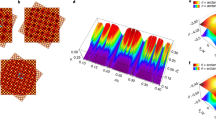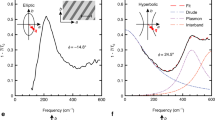Abstract
The engineering of the energy dispersion of polaritons in microcavities through nanofabrication or through the exploitation of intrinsic material and cavity anisotropies has demonstrated many intriguing effects related to topology and emergent gauge fields such as the anomalous quantum Hall and Rashba effects. Here we show how we can obtain different Berry curvature distributions of polariton bands in a strongly coupled organic–inorganic two-dimensional perovskite single-crystal microcavity. The spatial anisotropy of the perovskite crystal combined with photonic spin–orbit coupling produce two Hamilton diabolical points in the dispersion. An external magnetic field breaks time-reversal symmetry owing to the exciton Zeeman splitting and lifts the degeneracy of the diabolical points. As a result, the bands possess non-zero integral Berry curvatures, which we directly measure by state tomography. In addition to the determination of the different Berry curvatures of the multimode microcavity dispersions, we can also modify the Berry curvature distribution, the so-called band geometry, within each band by tuning external parameters, such as temperature, magnetic field and sample thickness.
This is a preview of subscription content, access via your institution
Access options
Access Nature and 54 other Nature Portfolio journals
Get Nature+, our best-value online-access subscription
$29.99 / 30 days
cancel any time
Subscribe to this journal
Receive 12 print issues and online access
$259.00 per year
only $21.58 per issue
Buy this article
- Purchase on Springer Link
- Instant access to full article PDF
Prices may be subject to local taxes which are calculated during checkout




Similar content being viewed by others
Data availability
The datasets generated and analysed during the current study are available in the Open Science Framework (OSF) repository via the following link: https://osf.io/x5h7v/?view_only=6a9fa8e1568343f797ec5a76d4626fe1
Change history
12 November 2021
A Correction to this paper has been published: https://doi.org/10.1038/s41565-021-01046-4
References
Aidelsburger, M., Nascimbene, S. & Goldman, N. Artificial gauge fields in materials and engineered systems. C. R. Phys. 19, 394–432 (2018).
J. Dalibard, Introduction to the physics of artificial gauge fields. Preprint at https://arxiv.org/abs/1504.05520 (2015).
Goldman, N., Budich, J. C. & Zoller, P. Topological quantum matter with ultracold gases in optical lattices. Nat. Phys. 12, 639–645 (2016).
Goldman, N., Juzeliunas, G., Öhberg, P. & Spielman, I. B. Light-induced gauge fields for ultracold atoms. Rep. Prog. Phys. 77, 126401 (2014).
Lu, L., Joannopoulos, J. D. & Soljacic, M. Topological photonics. Nat. Photon. 8, 821–829 (2014).
Hafezi, M. Synthetic gauge fields with photons. Int. J. Mod. Phys. B 28, 1441002 (2014).
Ozawa, T. et al. Topological photonics. Rev. Mod. Phys. 91, 015006 (2019).
Vozmediano, M. A., Katsnelson, M. & Guinea, F. Gauge fields in graphene. Phys. Rep. 496, 109–148 (2010).
Ren, Y., Qiao, Z. & Niu, Q. Topological phases in two-dimensional materials: a review. Rep. Prog. Phys. 79, 066501 (2016).
Huber, S. D. Topological mechanics. Nat. Phys. 12, 621–623 (2016).
Gao, T. et al. Observation of non-Hermitian degeneracies in a chaotic exciton–polariton billiard. Nature 526, 554–558 (2015).
Estrecho, E. et al. Visualising Berry phase and diabolical points in a quantum exciton–polariton billiard. Sci. Rep. 6, 37653 (2016).
Lim, H.-T., Togan, E., Kroner, M., Miguel-Sanchez, J. & Imamoglu, A. Electrically tunable artificial gauge potential for polaritons. Nat. Commun. 8, 14540 (2017).
Berry, M. V. Quantal phase factors accompanying adiabatic changes. Proc. R. Soc. Lond. A 392, 45–57 (1984).
Gianfrate, A. et al. Measurement of the quantum geometric tensor and of the anomalous Hall drift. Nature 578, 381–385 (2020).
Raghu, S. & Haldane, F. D. Analogs of quantum-Hall-effect edge states in photonic crystals. Phys. Rev. A 78, 033834 (2008).
Karzig, T., Bardyn, C. E., Lindner, N. H. & Refael, G. Topological polaritons. Phys. Rev. 5, 031001 (2015).
Kavokin, A., Malpuech, G. & Glazov, M. Optical spin Hall effect. Phys. Rev. Lett. 95, 135501 (2005).
Bardyn, C. E., Karzig, T., Refael, G. & Liew, T. C. Topological polaritons and excitons in garden-variety systems. Phys. Rev. B Condens. Matter Mater. Phys. 91, 161413 (2015).
Nalitov, A. V., Solnyshkov, D. D. & Malpuech, G. Polariton Z topological insulator. Phys. Rev. Lett. 114, 116401 (2015).
Klembt, S. et al. Exciton–polariton topological insulator. Nature 112, 552–556 (2018).
Jacqmin, T. et al. Direct observation of Dirac cones and a flatband in a honeycomb lattice for polaritons. Phys. Rev. Lett. 112, 116402 (2014).
Real, B. et al. Semi-Dirac transport and anisotropic localization in polariton honeycomb lattices. Phys. Rev. Lett. 125(18), 186601 (2020).
Milicévic, M. et al. Orbital edge states in a photonic honeycomb lattice. Phys. Rev. Lett. 118, 107403 (2017).
Scafirimuto, F., Urbonas, D., Scherf, U., Mahrt, R. F. & Stöferle, T. Room-temperature exciton–polariton condensation in a tunable zero-dimensional microcavity. ACS Photonics 5, 85–89 (2018).
Su, R. et al. Observation of exciton polariton condensation in a perovskite lattice at room temperature. Nat. Phys. 16, 301–306 (2020).
Pedesseau, L. et al. Advances and promises of layered halide hybrid perovskite semiconductors. ACS Nano 10, 9776–9786 (2016).
Saparov, B. & Mitzi, D. B. Organic–inorganic perovskites: structural versatility for functional materials design. Chem. Rev. 10, 4558–4596 (2016).
Thouin, F. et al. Stable biexcitons in two-dimensional metal–halide perovskites with strong dynamic lattice disorder. Phys. Rev. Mater. 2, 034001 (2018).
Polimeno, L. et al. Observation of two thresholds leading to polariton condensation in 2D hybrid perovskites. Adv. Opt. Mater. 8, 2000176 (2020).
Fieramosca, A. et al. Two-dimensional hybrid perovskites sustaining strong polariton interactions at room temperature. Sci. Adv. 5, 9967 (2019).
Rechcinska, K. et al. Engineering spin–orbit synthetic Hamiltonians in liquid-crystal optical cavities. Science 366, 727–730 (2019).
Ren, J. et al. Nontrivial band geometry in an optically active system. Nat. Comm. 12, 689 (2021).
Lédée, F. et al. Fast growth of monocrystalline thin films of 2D layered hybrid perovskite. CrystEngComm 19, 2598–2602 (2017).
Fieramosca, A. et al. Chromodynamics of photons in an artificial non-Abelian magnetic Yang–Mills field. Preprint at https://arxiv.org/abs/1912.09684 (2019).
Donati, S. et al. Twist of generalized skyrmions and spin vortices in a polariton superfluid. Proc. Natl Acad. Sci. USA 113, 14926–14931 (2016).
Berry, M. V. & Dennis, M. R. The optical singularities of birefringent dichroic chiral crystals. Proc. R. Soc. Lond. A 459, 1261–1292 (2003).
Bleu, O., Solnyshkov, D. D. & Malpuech, G. Measuring the quantum geometric tensor in two-dimensional photonic and exciton–polariton systems. Phys. Rev. B 97, 195422 (2018).
Waltersperger, S. et al. PRIGo: a new multi-axis goniometer for macromolecular crystallography. J. Synchrotron Radiat. 22, 895–900 (2015).
Kabsch, W. XDS. Acta Crystallogr. D 66, 125–132 (2010).
Giacovazzo, C. Phasing in Crystallography: A Modern Perspective (Oxford Univ. Press, 2014).
Burla, M. C. et al. Crystal structure determination and refinement via SIR2014. J. Appl. Crystallogr. 48, 306–309 (2015).
Sheldrick, G. M. SHELXT—integrated space-group and crystal-structure determination. Acta Crystallogr. A 71, 3–8 (2015).
Acknowledgements
We acknowledge P. Cazzato for technical support, I. Tarantini for metal evaporation, and D. Gerace and A. Gianfrate for useful discussions. We acknowledge the project PRIN Interacting Photons in Polariton Circuits (INPhoPOL) (Ministry of University and Scientific Research (MIUR), 2017P9FJBS_001), the project TECNOMED—Tecnopolo di Nanotecnologia e Fotonica per la Medicina di Precisione (Ministry of University and Scientific Research (MIUR) Decreto Direttoriale number 3449 of 4 December 2017, CUP B83B17000010001) and the Accordo bilaterale CNR/RFBR (Russia)—triennio 2021–2023. G.G. gratefully acknowledges the project PERSEO-PERrovskite-based Solar cells: Towards High Efficiency and Long-term Stability (Bando PRIN 2015, Italian Ministry of University and Scientific Research (MIUR) Decreto Direttoriale number 2488 of 4 November 2015, project number 20155LECAJ). D.D.S. and G.M. acknowledge the support of the projects EU QUANTOPOL (846353), Quantum Fluids of Light (ANR-16-CE30-0021), ANR Labex GaNEXT (ANR-11-LABX-0014) and ANR programme ‘Investissements d’Avenir’ through the IDEX-ISITE initiative 16-IDEX-0001 (CAP 20-25). Q.X. gratefully acknowledges the National Natural Science Foundation of China (number 12020101003), strong support from the State Key Laboratory of Low-Dimensional Quantum Physics and a start-up grant from Tsinghua University. The funders had no role in study design, data collection and analysis, decision to publish or preparation of the manuscript. For theoretical information, contact D.D.S. (dmitry.solnyshkov@uca.fr); for materials information, contact L.D.M. (luisa.demarco@nanotec.cnr.it).
Author information
Authors and Affiliations
Contributions
L.P. realized the experiments with the help of M.D.G. and G.L. D.S., G.L. and M.D.G. supervised the experimental part with the help of V.A., F.T. and D.B. L.P, L.D.M., A.C., M.P., C.T.P., Q.X., A.F. and V.M. fabricated the samples. A.M. and C.G. carried out the structure characterization by single-crystal X-ray diffraction and V.O. performed X-ray measurements. D.D.S., G.M., G.L. and L.D. performed the treatment of the experimental data. D.D.S. and G.M. performed analytical calculations. L.P., M.D.G., L.D. with the help of G.L. and D.S. wrote the manuscript with input from all the authors. All authors have contributed to the discussion of the work.
Corresponding authors
Ethics declarations
Competing interests
The authors declare no competing interests.
Additional information
Peer review information Nature Nanotechnology thanks the anonymous reviewers for their contribution to the peer review of this work.
Publisher’s note Springer Nature remains neutral with regard to jurisdictional claims in published maps and institutional affiliations.
Extended data
Extended Data Fig. 1 Temperature dependence.
Comparison of the energy vs the ky in-plane momentum dispersion maps of the photoluminescence intensity at 9 T as function of the temperature of a 3 μm-thick single crystal. As the temperature increases, the exciton moves towards higher energy, inducing the increase of the photonic fractions for all polariton bands. d), e), f) Experimental Berry curvature extracted from the polarization-resolved measurements, for the band 2 at D) 4 K, e) 50 K and D) 100 K. The photonic fraction of the band 1 increases from 0.344 at 4 K to 0.366 at 100 K. g) Asymmetry ratio (ratio between B0 and the maximal Bz value on the axis ky = 0 μm−1) versus temperature. The error bars indicate the measurement uncertainty.
Extended Data Fig. 2 Optical Setup.
Sketch of the optical setup.
Supplementary information
Supplementary Information
Supplementary discussion Sections I–X, Figs. 1–9 and Tables 1–4.
Rights and permissions
About this article
Cite this article
Polimeno, L., Lerario, G., De Giorgi, M. et al. Tuning of the Berry curvature in 2D perovskite polaritons. Nat. Nanotechnol. 16, 1349–1354 (2021). https://doi.org/10.1038/s41565-021-00977-2
Received:
Accepted:
Published:
Issue Date:
DOI: https://doi.org/10.1038/s41565-021-00977-2
This article is cited by
-
Quasi-two dimensional Ruddlesden-Popper halide perovskites for laser applications
Frontiers of Physics (2024)
-
Exciton polariton interactions in Van der Waals superlattices at room temperature
Nature Communications (2023)
-
Coupled quantum vortex kinematics and Berry curvature in real space
Communications Physics (2023)
-
Deterministic and replaceable transfer of silver flakes for microcavities
Frontiers of Physics (2023)
-
Manipulating polariton condensates by Rashba-Dresselhaus coupling at room temperature
Nature Communications (2022)



